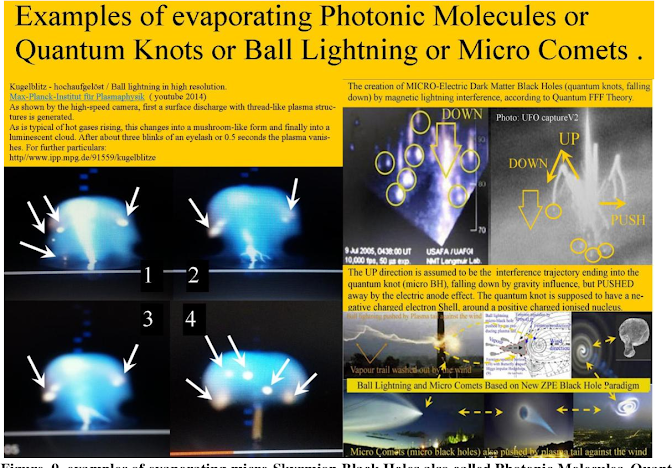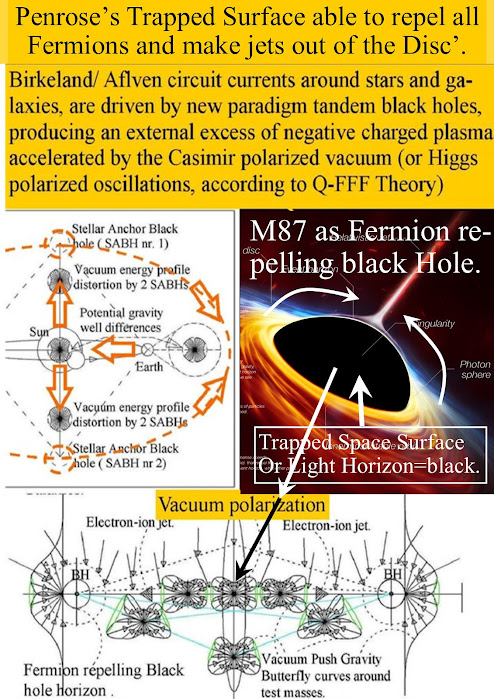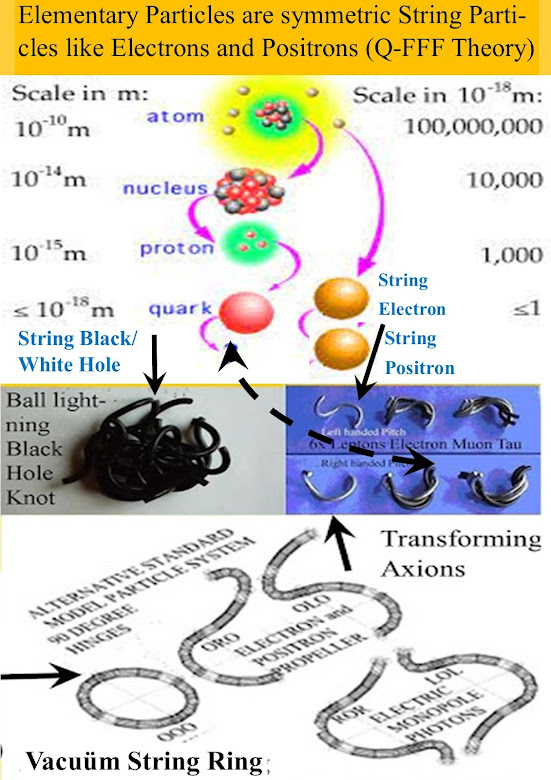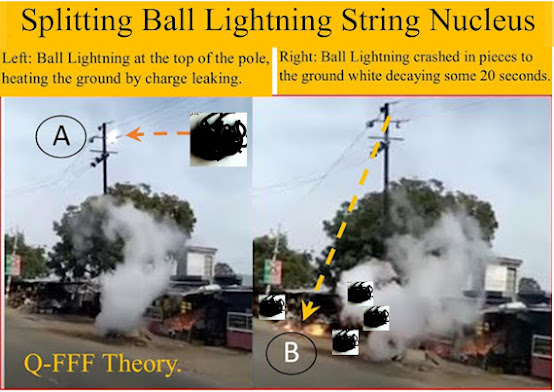
The Q-FFF Rigid String Theory says: (1) There is only one CONSTRUCTIVE Topological and Resilient TRANSFORMING STRING (Axion/vacuum Dark Energy building block ), forming direct after the Black Hole Splitting Big Bang. so called Travelling TADPOLE Black Hole based Filaments, expanding the Cosmic Lyman Alpha Structure. (2) A Raspberry Entangled 12x Mirror Copy Multiverse is Postulated as base for uncertainty (ER=EPR) and Libet's FREE VETO WILL . SO We live inside an exploded BH
Quantum FFF Rigid String Theory ( FFF= Function Follws string Form)
QUANTUM FFF topological STRING THEORY and the Fermion Propeller.http://vixra.org/author/leo_vuykhttps://www.flickr.com/photos_user.gne?path=&nsid=93308747%40N05&page=&details=1If the big bang was the splitting of a huge Axion/ Higgs particle Dark Matter Black Hole (ELISIUM DM- BH) nucleus into smaller DM-BH nuclei, then no standard Fermion/ Baryon inflation has happened only the DM-BH based Lyman alpha forest equipped with local Herbig Haro star/galaxy creating systems.
All black holes of all sizes (down to ball lightning) seem to be equipped with a Fermion repelling- and plasma producing horizon, which has also a charge splitting effect into a negative (outside) and positive ( inside) zone ( see oriental basin of the moon) .Conclusion, all Bhs are: "Negative Charged Electric Dark Matter Black Holes" with a rigid open string sector with intrinsic 3x hinging curvature.
Sunday, November 20, 2022
Micro Ball lightning in high resolution observed inside a glowing plasma ball as different hotspots above the water experiment.
Friday, November 18, 2022
Wednesday, November 16, 2022
Solving the Insoluble Problem: by the new Dark Matter String Nucleus BLACK HOLE BIG BANG
Solving the Insoluble in String Theory.
According to Roger Penrose each black hole is equipped with a "Trapped Spacetime Horizon" (TSHorizon)
Quantum FFF Theory says: That these TSHorizons REPEL ALL FERMIONS at close distance due to the spinning propeller shape of fermions.
As a consequence,
All fermion disc plasma matter around a black hole and spagettified stars, can not enter the black hole and will be expelled by both concentrated Plasma jets or forming a single plasma tail, such as "Tedpole" micro black holes seem to do pushing the black hole Tedpole BH nuclear head away from local gravity centers.
The TSHorizon outside the light horizon according to the Q-FFF Theory Model: ( Quantum Function Follows Form) is negative charged at the outside and positive at the inside. So the equal sized black holes repel each other and form Herbig Haro systems forming stars by polarizing the local vacuum .
James Webb Telescope just detected the most massive linear Red Hues Structure in the universe.( Abell 3667)
Abell 3667 (below) is currently observed to Have RED HUES on both sides, representing both original Big Bang Black Holes of the first Star and later galaxy able to merge into a cluster etc. ( Q-FFF Theory) Below: red (yellow) Hues on both sides of the cluster.
see: What is Wrong with Current Physics, to Explain Ball Lightning.
https://vixra.org/pdf/2101.0131v3.pdf
How Israel Destroys Drones with Laser Weapon
Laser Shooting Drones outside an iron dome in Israel.
see: https://www.youtube.com/watch?v=5IkbMz8xa_A
However, more effectively is three lasers or even more combined into one by mirrors: to produce real artificial ball lightning see: below.
PAH emission in Seyfert galaxies using JWST/MRS data. Direct out of the ;local Black Hole?? ( Q-FFF Model)
Received: 24 August 2022 Accepted: 20 September 2022
A high angular resolution view of the PAH emission in Seyfert galaxies using JWST/MRS data
Abstract
Polycyclic aromatic hydrocarbons (PAHs) are carbon-based molecules that are ubiquitous in a variety of astrophysical objects and environments. In this work we use JWST/MIRI MRS spectroscopy of three Seyferts to compare their nuclear PAH emission with that of star-forming (SF) regions. This study represents the first of its kind to use sub-arcsecond angular resolution data of local luminous Seyferts (Lbol > 1044.46 erg s−1) with a wide wavelength coverage (4.9–28.1 μm). We present an analysis of their nuclear PAH properties by comparing the observed ratios with PAH diagnostic model grids derived from theoretical spectra. Our results show that a suite of PAH features is present in the innermost parts of luminous Seyfert galaxies (∼0.45″ at 12 μm; in the inner ∼142–245 pc). We find that the nuclear regions of active galactic nuclei (AGN) lie at different positions of the PAH diagnostic diagrams, whereas the SF regions are concentrated around the average values of SF galaxies. In particular, we find that the nuclear PAH emission mainly originates in neutral PAHs. In contrast, PAH emission originating in the SF regions favours ionised PAH grains. The observed PAH ratios in the nuclear region of the AGN-dominated galaxy NGC 6552 indicate the presence of larger PAH molecules compared with those of the SF regions. Therefore, our results provide evidence that the AGN have a significant impact on the ionisation state (and probably the size) of the PAH grains on scales of ∼142–245 pc.
Our results show that a suite of PAH features is present in the innermost parts of luminous Seyfert galaxies
However, PAH emission originating in the SF regions favours ionised PAH grains.
The observed PAH ratios in the nuclear region of the AGN-dominated galaxy NGC 6552 indicate the presence of larger PAH molecules compared with those of the SF regions.
Therefore, our results provide evidence that the AGN have a significant impact on the ionisation state (and probably the size) of the PAH grains on scales of ∼142–245 pc.
see: https://www.aanda.org/articles/aa/full_html/2022/10/aa44806-22/aa44806-22.html




.png)





















.png)


.jpg)



















.jpg)


.png)